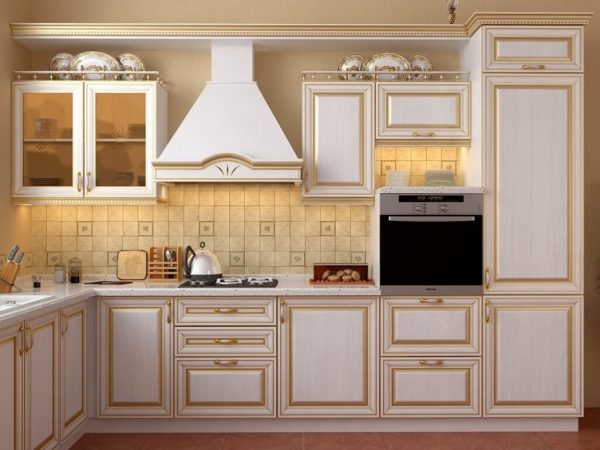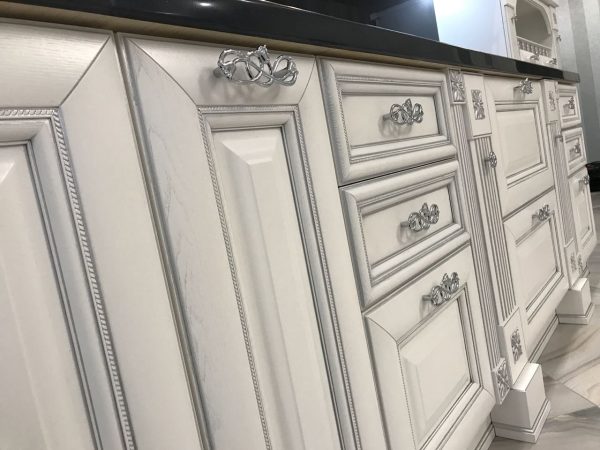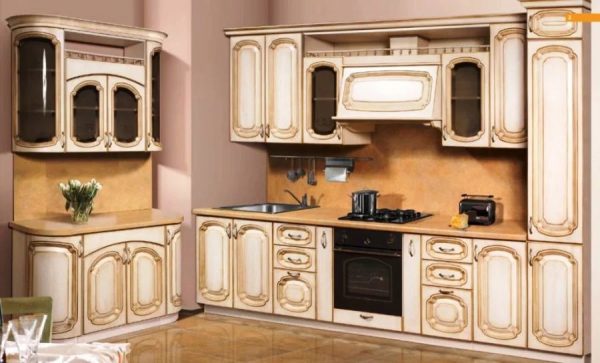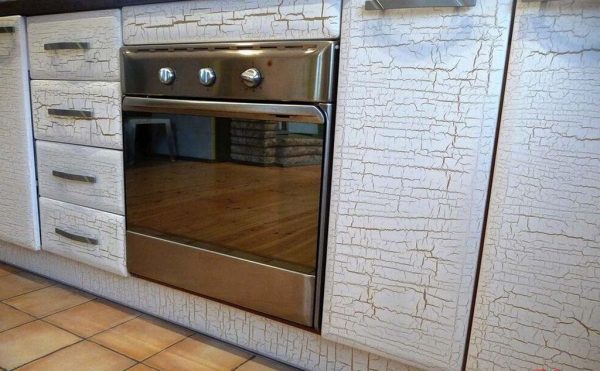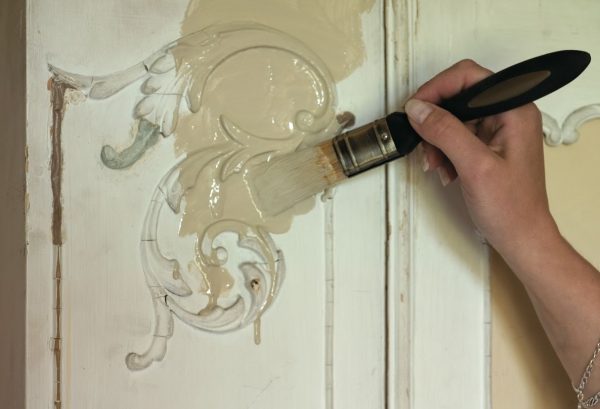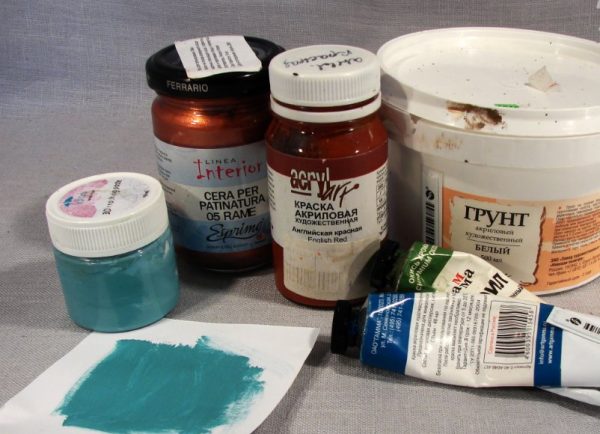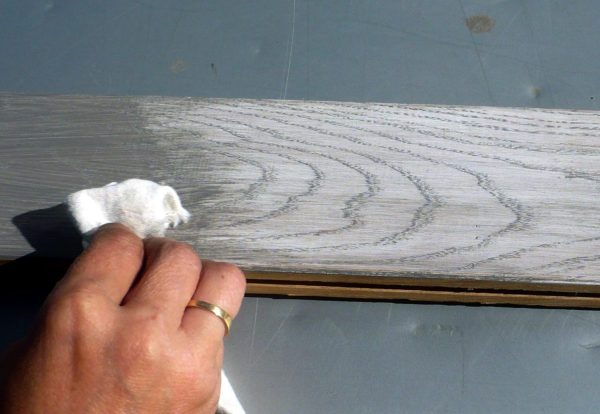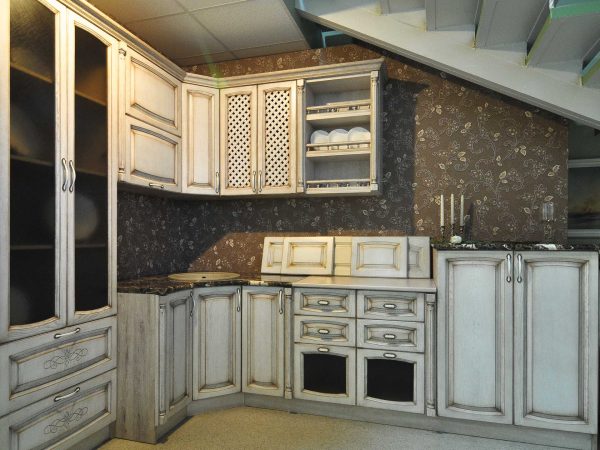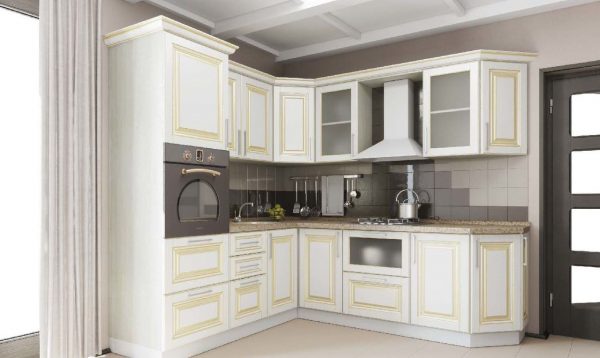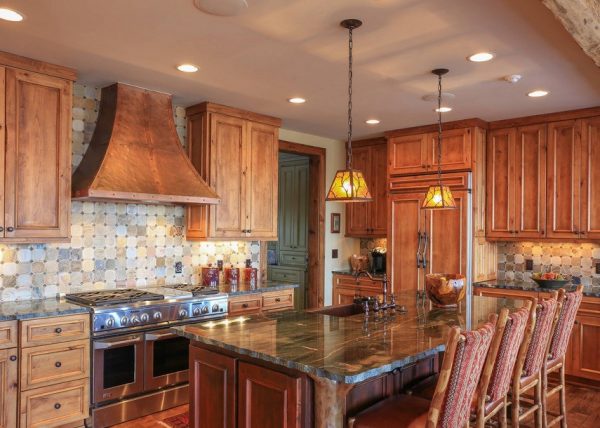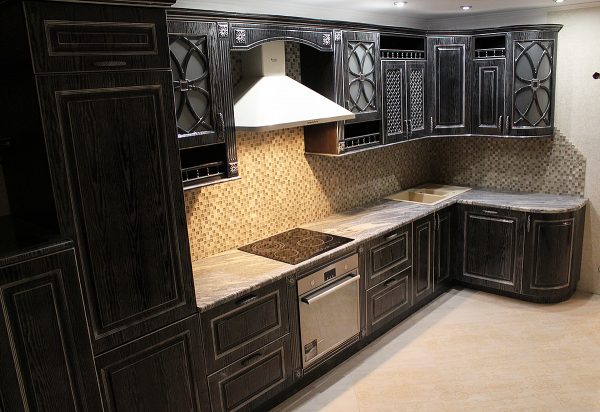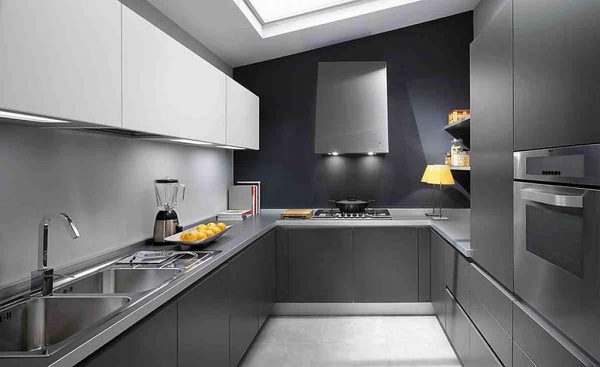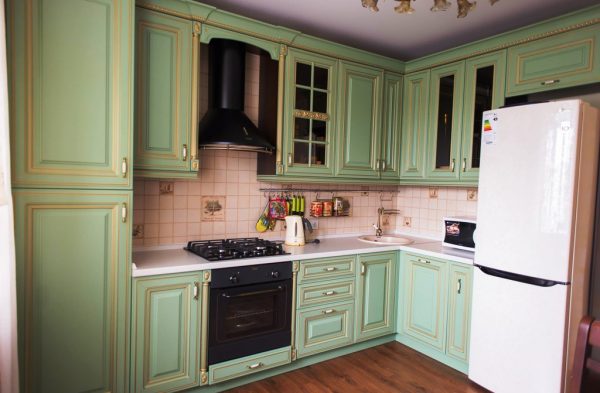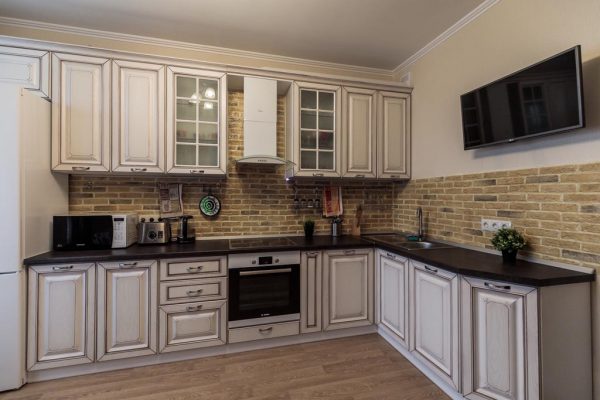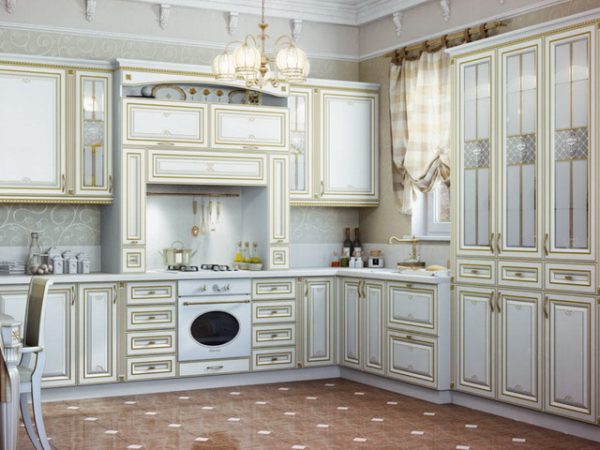Patina on furniture is a natural phenomenon that invariably occurs with aging. For such traces to appear on wood, many years will pass, because the natural material is quite resistant to adverse factors.
- Advantages and disadvantages of a patinated kitchen
- Varieties of patina
- Golden and silver patina
- Contrast Patina
- Craquelure (crackle)
- Types and techniques of patination
- Furniture acrylic coating
- Artificial cracking
- Soaking
- Headset selection and decorative effect
- Patina colors
- White
- Brown
- Black
- Beige and ivory
- Gray
- Green
- Red
- What interior style should I choose for a patina kitchen?
- Classic
- Provence
- Do it yourself patinated kitchen
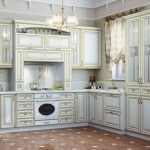
Now patina is considered a fashionable effect, therefore it is created artificially on various wooden products. Kitchens with a patina look expensive and noble, fit perfectly into the classics and vintage styles.
Advantages and disadvantages of a patinated kitchen
Patina is understood as plaque that forms on wood and metal due to prolonged contact with oxygen. If there is a patina, the main color looks brighter, and slight darkening, small cracks appear on the surface, so that the furniture looks like antique. Such plaque can be created independently, it is only important to apply methods and coatings that do not harm wood or metal.
Advantages of patina on kitchen furniture:
- Extra protection. Using patination technology allows you to cover the elements of the headset with a durable film, as well as varnish, which is usually applied as a finish. Facades eventually become stronger, last longer, less prone to damage.
- Practicality. Thanks to the protective coating, the care of the kitchen will become much easier, the facades can be washed without harm to their condition. Stains on patinated surfaces are less noticeable than on ordinary ones.
- Aesthetics. Patination makes furniture interesting and expensive to look at. Even a simple kitchen set from MDF will look luxurious and stylish.
- The ability to restore products. Old furniture that has already lost its external gloss can be restored with patination. This will seriously save money on the purchase of new furniture, especially if all the work will be done independently.
to contents ↑It should be remembered that the application of the film does not increase the fire resistance of the facades, so when cooking it will be necessary to strictly observe safety precautions. The plate must be placed at some distance from the elements coated with flammable paints. It is also not recommended to ennoble work surfaces with a patina: with frequent and strong mechanical stress, they will deteriorate.
Varieties of patina
Patina is distinguished by shades and decorative effect. The choice of its specific form depends on the style of the kitchen, the color design of the walls, floor, textiles and other components, on the basic tone of the headset itself.
Golden and silver patina
Patination in the colors of gold and silver is considered a classic option, while the most common. Metal plaque successfully suits the white and black kitchen, as well as furniture made in light wood tones.Top gold and silver patina is recommended to be coated with matte varnish, then it looks even more advantageous.
to contents ↑Contrast Patina
Contrast will help to elegantly emphasize carved patterns on wooden furniture facades. Usually the headsets are made in a lighter shade, and the old coating on the facades is saturated in color. Most often, frames, corners, joints of parts are darkened.
to contents ↑Craquelure (crackle)
This patination option is perfect for country styles, Provence, shabby chic. To implement the technique, a special craquelure varnish is used, which after drying creates a network of small cracks, and the surface resembles an old paint.
to contents ↑Types and techniques of patination
Patina can be divided into two large groups: artificially created and natural (natural). Artificial plaque can be created by various methods that are suitable for wood massif, and for veneer, MDF. By style, patination happens:
- thin layer;
- filling in;
- aging with mashing.
The latter option does not involve the usual application of a surface coating, but rubbing special agents into the wood structure. There are two main patination technologies used in industry:
- membrane vacuum pressing;
- manual application of paints, varnishes.
At home, the second method is used, which involves coating with acrylic paints, stains and special varnishes.
to contents ↑Furniture acrylic coating
This method is considered the simplest when patinating kitchen facades. You just need to purchase high-quality paint in a suitable shade that will go well with the main tone of the headset (for example, a golden patina is ideal for a beige kitchen).
After preparation, priming, a base tone is applied to the front of the facade, which forms the basis and levels the surface. After drying with light jerky strokes, a second coat of paint for the patina is performed, mainly along the bulges and depressions.
The flat surface of the parts remains homogeneous, due to which the headset will look as if touched by a touch of antiquity. You can also do it in another way: polish the base coat with emery cloth, then easily go over it with an acrylic composition for patination.
to contents ↑Artificial cracking
This technique is called craquelure and is more complex in execution. It involves the creation of a network of cracks and aging of the surface with artificial “plaque”. After gradual application of facet varnish, when the previous layer is not completely dried, cracks appear by themselves. After the base has been completely dried, it is wiped with a patinating compound to make the space between the cracks darker. To consolidate the result, the facades are covered with a finish varnish.
to contents ↑Soaking
After applying the stain on a water or wax basis, the tree becomes darker, grayer, while its internal structure will be clearly traced. It is important to choose the right color of the composition so that it gives the wood a similarity to the aged. Stain is suitable only for natural wood, it does not make sense to use it on MDF or veneer.
to contents ↑Headset selection and decorative effect
Most often, when choosing a kitchen set, the designer offers a golden or silver patina - it is ideal for classic furniture colors. But if you wish, you can choose a less universal option - black, gray, yellow and even red patina. It is better if non-standard solutions contrast with the basic tone of the headset, then they will look most attractive.
Recommendations for buying a kitchen with patina:
- It is worth to know in advance which method of patination the manufacturer uses. A more resistant coating is that it was applied in several layers. It will look natural, expensive.
- For classics, they select a kitchen with a slight effect of antiquity, where the patina is slightly darker than the main facades. For headsets with complex milling, it is also not necessary to make the facades too dark, and a lot of gold and silver will look too catchy at all.
- If you decide to purchase a kitchen with a craquelure effect, it is important that a reliable varnish is applied in several layers. The fact is that such a coating itself is fragile and requires particularly strong external protection.
- Gloss is poorly combined with patina, because with natural aging of a tree, gloss on its surface is not observed. Therefore, most patinated kitchen sets have a matte finish.
- Fittings must be appropriate. It is performed artificially aged or made suitable for the facades in style, color.
- If you want to give the furniture a greater texture, before patinating the parts are brushed - treated with a stiff brush to remove soft fibers. As a result, irregularities are created on the basis of which very successfully look after patination.
to contents ↑The most inexpensive kitchen sets have simple, even facades without carving and pattern. Therefore, with a limited budget, you can order such furniture, and then make it with your own hands. A medium-priced option is a veneer kitchen, and MDF headsets are economy class. The most expensive are considered products from solid beech, oak, ash and other hardwoods.
Patina colors
To successfully choose the coloring of the kitchen, it is worth comparing the basic tone of the facades and patina, as well as taking into account other important nuances.
White
White kitchen is a good solution for most styles. This tone looks elegant, beautiful, fresh, while neutral. White facades will be in harmony with any shade of patina, reminiscent of antiques. You can decorate such a kitchen with green, blue, purple tones, as well as silver and gold.
to contents ↑Brown
This option is great for country style, helps bring the interior closer to the rustic one. Patina on brown facades can be made gray, greenish, bluish, beige. In the classical style, it is better to take gold paint for patination.
to contents ↑Black
After applying the patina, the black facades of the kitchen set will take on a rather unusual look. It is not always possible to apply such a design: for example, it is not suitable for complex, carved furniture. It is necessary that the headset is simple in design, and the room itself is light, spacious. Patina should be made gold, silver or white, as well as accessories.
to contents ↑Beige and ivory
Such tones are perfect for classics, Provence, a patina of any color is combined with them. To keep the kitchen tender and bright, it is worthwhile to patinate with not too dark tones: gray, blue, greenish, lilac, golden.
Gray
The steel-colored kitchen looks expensive and noble. The most luxurious combination is obtained with a patina of white, black, blue. This solution is especially good for small-sized kitchens, although in a spacious room it will also look good.
to contents ↑Green
This option is ideal for the style of shabby chic, because the green facades are elegant and delicate, airy in appearance. In order not to visually overload the kitchen, do not use saturated tones of greenery, it will be better to look lighter. Green successfully combines with a patina of beige, brown, white, gray.
to contents ↑Red
Red furniture in the kitchen is a bright and bold option, but quite appropriate for this room. It is important not only to abuse too juicy tones, but to choose more muffled, closer to burgundy. With different shades of red, the patina of black, brown, beige, gray, white is not bad.
What interior style should I choose for a patina kitchen?
Since antiquity makes furniture look antique, such a solution will not fit into every type of design. For example, patination for furniture in modern styles is not suitable: techno, hi-tech, modern. This technique looks best when decorating the kitchen in such areas as classic, country, Provence, vintage, shabby chic and in the antique style.
Classic
The main qualities inherent in the classics are aristocracy and elegance; it is precisely them that can significantly enhance the use of patina on kitchen furniture. The noble touch of antiquity here will be either a self-sufficient decoration, or it will be successfully combined with carved details, interesting patterns.
to contents ↑The most beautiful are the upper cabinets for the ceiling. Combined wardrobes are no less suitable for the classical style: in them dull facades alternate with glass details and lattice sections. If there is a lot of decor, accessories, jewelry, patina is better to make more restrained in color. A modest kitchen will be decorated with patination of gold, silver.
Provence
Aged elements, darkened parts from time to time, are also welcomed in this style. Matte bases, a dark patina on a light background, and interesting accessories are especially suitable for Provence. Most often, crackle technology is used here, giving the surface the appearance of cracked paint.
Do it yourself patinated kitchen
Putting a patina on the doors of a kitchen set yourself is an entirely feasible task. The technique is not complicated and will allow you to update boring furniture in a short time. Patination requires strict adherence to technology:
- Grind the facades with sandpaper with grain No. 180.
- To treat the surface with a barrier-primer using a spray gun, if we are talking about MDF facades, and stain, if we are dealing with natural wood.
- Apply self-leveling varnish, dry, then spray the patina (unevenly, more clearly - along the edges, bulges).
- Sand the surface.
- Coat the facades with colorless matte varnish.
Usually only the outer part of the facades is patinated, but if desired, work can also be done from the inside of the products. The headset will look elegant and unusual, while the created protective film will extend its service life by several years.

